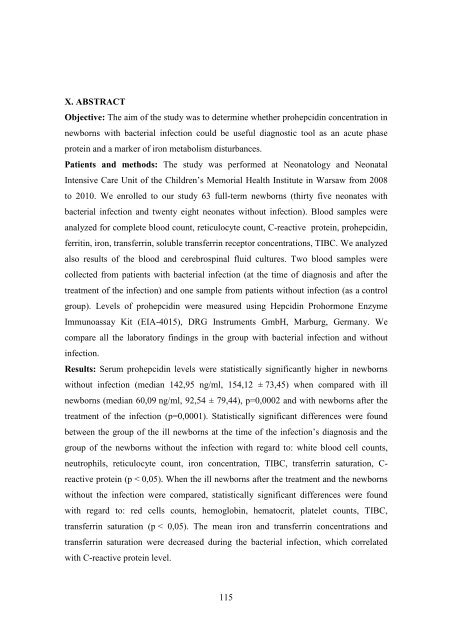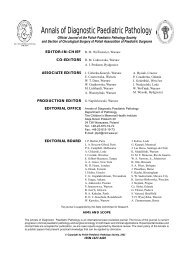Ocena przydatnoÅci oznaczania prohepcydyny w przebiegu ...
Ocena przydatnoÅci oznaczania prohepcydyny w przebiegu ...
Ocena przydatnoÅci oznaczania prohepcydyny w przebiegu ...
Create successful ePaper yourself
Turn your PDF publications into a flip-book with our unique Google optimized e-Paper software.
X. ABSTRACT<br />
Objective: The aim of the study was to determine whether prohepcidin concentration in<br />
newborns with bacterial infection could be useful diagnostic tool as an acute phase<br />
protein and a marker of iron metabolism disturbances.<br />
Patients and methods: The study was performed at Neonatology and Neonatal<br />
Intensive Care Unit of the Children’s Memorial Health Institute in Warsaw from 2008<br />
to 2010. We enrolled to our study 63 full-term newborns (thirty five neonates with<br />
bacterial infection and twenty eight neonates without infection). Blood samples were<br />
analyzed for complete blood count, reticulocyte count, C-reactive protein, prohepcidin,<br />
ferritin, iron, transferrin, soluble transferrin receptor concentrations, TIBC. We analyzed<br />
also results of the blood and cerebrospinal fluid cultures. Two blood samples were<br />
collected from patients with bacterial infection (at the time of diagnosis and after the<br />
treatment of the infection) and one sample from patients without infection (as a control<br />
group). Levels of prohepcidin were measured using Hepcidin Prohormone Enzyme<br />
Immunoassay Kit (EIA-4015), DRG Instruments GmbH, Marburg, Germany. We<br />
compare all the laboratory findings in the group with bacterial infection and without<br />
infection.<br />
Results: Serum prohepcidin levels were statistically significantly higher in newborns<br />
without infection (median 142,95 ng/ml, 154,12 ± 73,45) when compared with ill<br />
newborns (median 60,09 ng/ml, 92,54 ± 79,44), p=0,0002 and with newborns after the<br />
treatment of the infection (p=0,0001). Statistically significant differences were found<br />
between the group of the ill newborns at the time of the infection’s diagnosis and the<br />
group of the newborns without the infection with regard to: white blood cell counts,<br />
neutrophils, reticulocyte count, iron concentration, TIBC, transferrin saturation, C-<br />
reactive protein (p < 0,05). When the ill newborns after the treatment and the newborns<br />
without the infection were compared, statistically significant differences were found<br />
with regard to: red cells counts, hemoglobin, hematocrit, platelet counts, TIBC,<br />
transferrin saturation (p < 0,05). The mean iron and transferrin concentrations and<br />
transferrin saturation were decreased during the bacterial infection, which correlated<br />
with C-reactive protein level.<br />
115
















